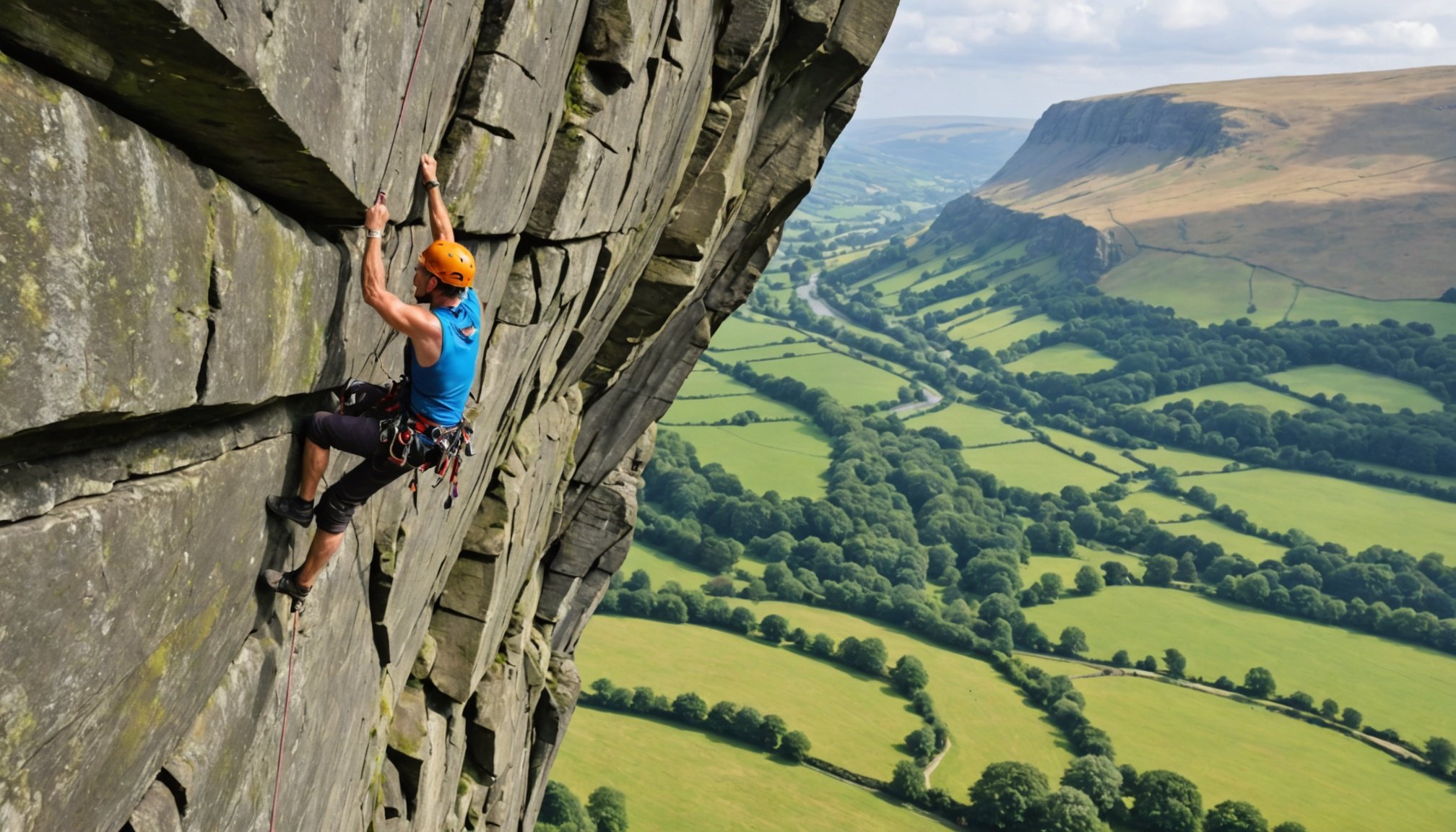Overview of Rock Climbing in the Peak District
In the realm of adventure travel, the Peak District stands as a beacon for enthusiasts seeking thrilling outdoor activities. This region is renowned as one of the premier rock climbing destinations, beckoning climbers from all over the globe. Its diverse landscape presents a variety of climbing styles suitable for different skill levels, from trad climbing to bouldering.
The Peak District’s natural beauty significantly enhances the rock climbing experience. The local scenery, characterized by rugged cliffs and serene valleys, not only provides a stunning backdrop but also contributes to the physical and mental challenges climbers cherish. The combination of breathtaking views and challenging terrain makes every ascent a memorable adventure.
Additional reading : Discover Your Perfect Isle of Skye Retreat: Breathtaking Hiking Adventures Await!
Additionally, the Peak District offers an array of climbing routes that cater to both beginners and seasoned climbers. These well-marked paths, peppered across popular locations, ensure that climbers can always find a suitable challenge. Moreover, the community of climbers in the area fosters a supportive environment, promoting safety and camaraderie.
For anyone looking to indulge in outdoor activities, the Peak District provides a comprehensive and exhilarating rock climbing experience, making it a must-visit for adventure seekers.
Topic to read : Unlock Your Perfect Hadrian’s Wall Getaway: Top Tips for Memorable Historical Adventures
Top Rock Climbing Locations
The Peak District offers a plethora of crags and climbing routes that cater to various skill levels. Enthusiasts will find the best spots scattered across different areas known for their unique challenges and breathtaking views.
Iconic Climbing Areas
One cannot discuss Peak District climbing without mentioning Stanage Edge. As the largest and most popular gritstone escarpment, it offers numerous routes of varying degrees of difficulty. The rock’s natural formations appeal to both trad climbers and boulderers looking for a challenge.
Another must-visit location is Froggatt Edge. Known for its well-proportioned routes, this location suits climbers seeking a balance of difficulty and aesthetic appeal. Froggatt boasts classic climbs like “Three Pebble Slab,” ideal for testing technique and endurance.
Lastly, The Roaches stand out with their rugged gritstone faces and varied terrain. This area is treasured for its technical climbs and scenic beauty, catering to both seasoned climbers and beginners.
Climbing routes at these iconic areas offer stunning views, making them perfect spots for photographers and nature lovers alike. Convincingly, the grandeur of these climbs reaffirms the Peak District as a premier location within the realm of rock climbing.
Hidden Gems for Rock Climbers
Beyond the renowned crags, the Peak District harbours hidden gems offering climbers solitude and unique challenges. These lesser-known spots provide exceptional climbing experiences with quieter surroundings, perfect for those seeking adventure off the beaten path.
Dovedale is a picturesque valley, rich with limestone formations that present exciting climbs for intermediate to advanced climbers. The valley’s tranquil atmosphere enhances the intimate connection with nature, making it a haven for rock climbing connoisseurs. Meanwhile, Hen Cloud, a favourite among locals, offers remarkable gritstone ascents. Its majestic height and complex routes provide a thrilling venture for experienced alpinists.
Another highlight is Burbage South, which, although often overshadowed by its northern neighbour, promises exhilarating climbs amidst captivating sceneries. The variety of routes available caters to diverse skill levels while maintaining a peaceful environment.
For photographers and nature lovers, these hidden gems promise stunning vistas and abundant wildlife sightings. Incorporating these off-the-radar spots into your climbing itinerary will not only challenge your skills but also enrich your overall experience in the Peak District, leaving you with unforgettable memories.
Difficulty Levels and Suitable Times to Visit
When engaging in rock climbing in the Peak District, understanding the climbing difficulty is crucial for a safe and fulfilling experience. Climbing grades denote the technical challenges of routes. In the Peak District, grades often range from mild scrambles to intense, technical ascents. Beginners might find easier routes at lower grades, while experts often pursue higher-grade challenges for ultimate thrills.
Seasonal climbing influences the experience significantly. The best times to visit the Peak District for climbing are spring and autumn. These seasons offer moderate weather, ensuring comfortable temperatures and reduced risk of slippery surfaces from rain or heat. It’s advisable to avoid climbing during the peak of winter due to potential hazards from snow and ice, as well as the summer, where excessive heat can pose risks.
Before embarking on a climbing trip, always check the local weather conditions for safety and optimal performance. Rainfall, wind speed, and temperature can impact not only personal safety but also the integrity of climbing equipment. Climbers are encouraged to stay updated with forecasts and be prepared to adjust plans if adverse weather is expected.
Equipment Rentals and Guiding Services
When planning a climb in the Peak District, ensuring access to quality climbing gear rental can set the tone for a safe and enjoyable adventure. Numerous local shops offer equipment tailored for various skill levels, providing everything from basic harnesses to advanced trad gear. It’s crucial to inspect the condition of rented equipment, focusing on features like harness integrity and rope durability.
For those enhancing their climbing skills, engaging with expert instructors through guided tours is highly recommended. These guides bring a wealth of experience, offering valuable insights into technique and risk management. They are an excellent choice for both novice climbers and those tackling more challenging routes.
In the Peak District, several reputable guiding services stand out due to their commitment to safety and climber satisfaction. With a guided climbing experience, expect a structured approach, incorporating safety briefings and personalized coaching that enhances both confidence and performance. Costs for equipment rentals and guided services vary, with many options catering to different budgets. Whether seeking a solo venture with reliable gear or a comprehensive expedition with a seasoned guide, the Peak District provides ample support for an unforgettable climbing experience.
Accommodation Options for Climbers
The Peak District offers a variety of climber-friendly accommodation options suited to diverse preferences and budgets. Whether you seek luxury or prefer to rough it in the great outdoors, the district caters to all.
For those looking for proximity to top climbing spots, several hotels and B&Bs provide easy access to renowned crags, ensuring that early morning starts are hassle-free. These establishments often feature facilities such as secure storage for equipment and drying rooms, which are invaluable after a day on the rocks.
Camping enthusiasts will find numerous well-maintained campsites tucked into scenic corners of the Peak District, offering a blend of affordability and immersion in nature. Many sites are conveniently located near popular Peak District crags, enabling climbers to fully enjoy the outdoor experience.
For a more upscale retreat, consider booking one of the picturesque lodges that dot the region. These luxury accommodations combine comfort with spectacular vistas, providing a perfect sanctuary after a day of adventure. Regardless of your choice, the Peak District ensures all climbers have comfortable bases from which to launch their adventures.
Safety Tips for Rock Climbing
Ensuring climbing safety in the Peak District is paramount to enjoying the adventure. Essential safety gear, such as helmets, harnesses, and secure ropes, should be prioritised. These items protect climbers from potential falls and injuries. Inspect equipment meticulously before each use, focusing on signs of wear and tear.
Risk management is crucial when rock climbing. Beginners and experts alike should always practice safe climbing with a partner or group. This not only provides more eyes to spot potential hazards but also ensures help is available in emergencies. Proper communication using established signals can prevent misunderstandings while climbing.
Being prepared for emergencies is as important as the climb itself. Climbers should familiarise themselves with local rescue services, understanding how to contact them if necessary. Carrying a small first-aid kit and knowledge of basic first aid can significantly aid in managing minor injuries on-site.
Emphasising good practices and preparedness enhances both safety and enjoyment. Embrace these strategies to mitigate risks and fully experience the beauty and challenges the Peak District rock climbing offers.






















